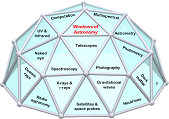Windows of Astronomy |
|||
Computation Surely I must be kidding to say that in staring at a computer screen we are looking into a window of astronomy? Even though almost every professional astronomer does it, that doesn’t make it a window. It can be, though. Astronomy is a very peculiar science. By and large you can look but not touch. It’s impossible to experiment on the universe at large. With a lot of effort, one can conduct simple experiments on a few nearby objects in the solar system but that’s not even a drop in the ocean compared with the universe. |
|||
 |
|||
Example of modelling the evolution of the large-scale structure of the universe by the National Science Foundation Center for Computational Physics. |
|||
Computing allows us to undertake experiments, not on the universe itself but on our understanding of it. If that understanding is good, then the computation will mimic what we see through our windows. For example, can we model the evolution of clusters of galaxies? Does the model produce the kind of structures we find in the universe? If we vary the amount of dark matter in the model, do we get better or worse answers? Can we model the dynamic behaviour of the Sun’s magnetic field in a way that produces realistic solar flares, or have we not yet understood the details of what is going on there? Do predictions of the evolution of the solar system over the past 4 billion years predict what we find is out there now? Can we understand the conditions that produce the very odd configurations found for a range of extra-solar planets? And so on. Not experiments on the universe but a window that truly increases our understanding of the universe.
| |||



